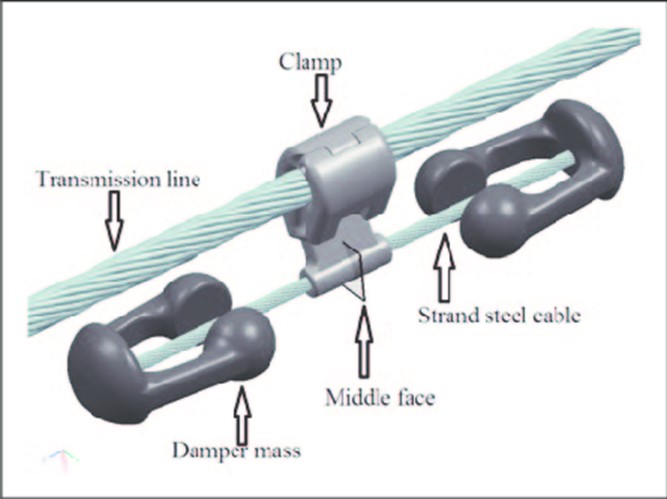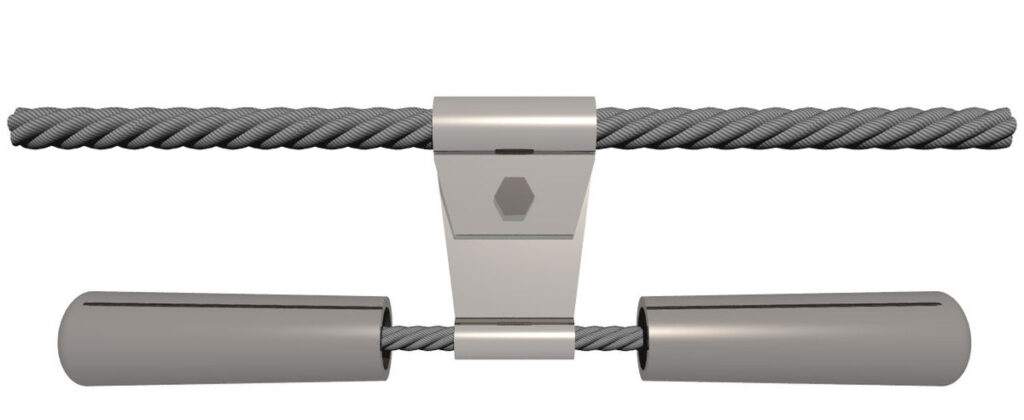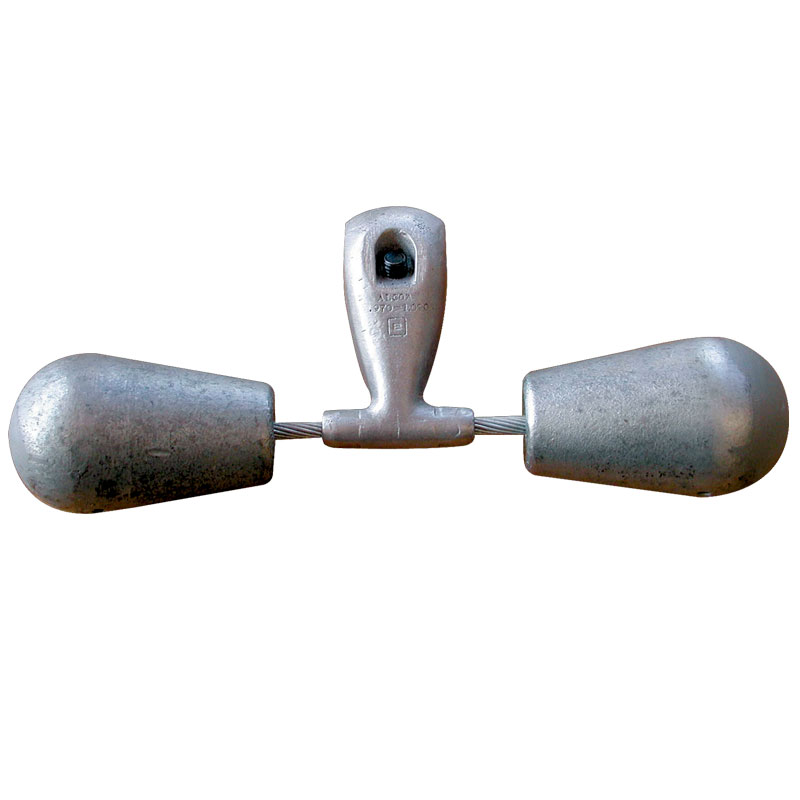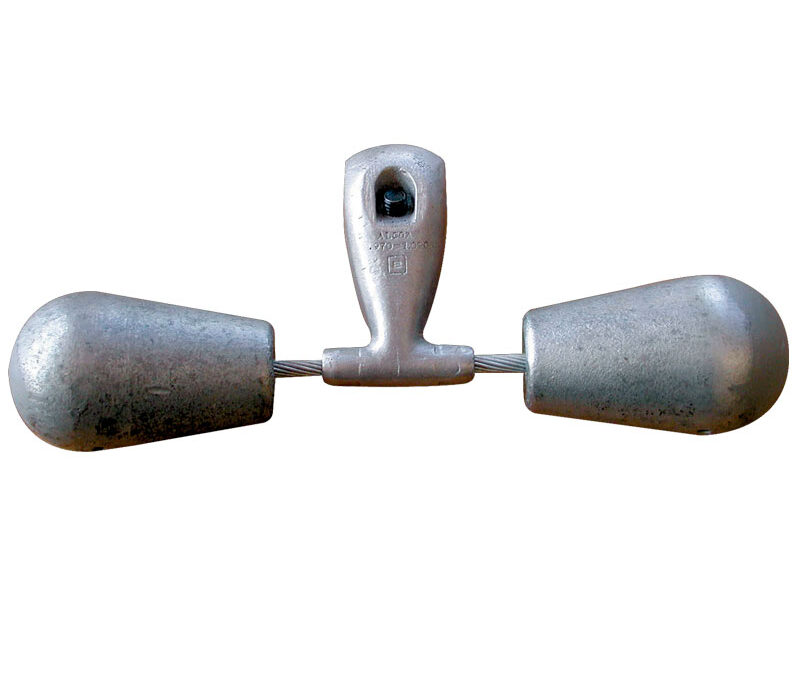A spiral vibration damper is a device used to lengthen the cable line’s service life. It is also known as a Stockbridge damper or an SVD. Spiral vibration damper helps to mitigate the effects of aeolian vibration. This is from wind-induced oscillations in the conductors which can lead to failures. The SVD consist of two masses connected to the conductor by means of helical springs. The masses position equidistant from the point of attachment to the conductor. They also have designs to oscillate out of phase with natural frequency of the conductor system. using spiral vibration ensures the structural integrity and longevity of the system. This is especially in areas prone to high winds or other environmental factors. Spiral vibration dampers are essential to maintain the reliability of the electrical grid.
Parts of a spiral vibration damper
Spiral vibration dampers consist of several key parts designed to dampen aeolian vibrations. The specific parts of the SVD vary depending on the design and manufacturer. The parts work together to provide effective damping of aeolian vibrations. This is to ensure the stability and reliability of the infrastructure. The following are the common parts of the spiral vibration damper.

- Weights – these are the primary damping elements of the damper. They are cylindrical in shape and attach to the conductor via springs. The weights also help stabilize the conductor and dissipate vibration energy.
- End fittings – these attach the spiral vibration damper to the conductor. They provide a secure connection while allowing the damper to move and respond to vibration.
- Housing – some of the spiral vibration dampers feature a housing or enclosure to protect the internal components. They protect them from environmental factors such as moisture, dust and UV radiation.
- Fasteners and hardware – these are fasteners used to assemble the damper and ensure the structural integrity. These include bolts, nuts, washers and other fastening elements.
- Springs – these help to connect the weights to the conductor. They have a helical shape that provides flexibility and allows the weights to move in response to wind-induced vibrations. They also store and release energy which helps mitigate oscillations in the transmission line.
- Mounting hardware – these help to secure the damper to the conductor or support structure. The hardware may be adjustable to accommodate different conductor sizes and configurations.
- Damping material – damping material may work within the damper to enhance its vibration damping capabilities. The material helps to absorb and dissipate vibration energy.
- Adjustment mechanism – the dampers may include an adjustment mechanism that allows for fine-tuning of the damping characteristics. This may allow for adjustments in spring tension to optimize performance in different wind conditions.
Benefits of using spiral vibration damper
Spiral vibration dampers play a crucial role in ensuring the reliability and performance of the systems. The following are the common benefits of using spiral vibration dampers.

- Environmental adaptability – SVDs have designs to withstand a variety of environmental conditions. These include high winds, temperature variations and exposure to UV radiation. This helps to ensure reliable performance in diverse geographical locations and climatic conditions.
- Improved power quality – line vibrations can affect the quality of power delivered to consumers. SVDs contribute to maintaining consistent power quality and reduce the risk of outages.
- Extended lifespan – this is by reducing the amplitude of vibration and mitigating the stresses on the conductors. This helps utilities and operators reduce maintenance costs and optimize the long-term performance of their assets.
- Vibration reduction – the primary benefit of spiral vibration dampers is to reduce vibration. This helps reduce the risk of fatigue failure in conductors, insulators and other components. This enhances the reliability and safety of the transmission system.
- Enhanced system reliability – vibration can lead to dynamic instabilities in transmission lines. spiral vibration dampers help stabilize the system by controlling the vibrations. They also ensure the lines remain in place even during adverse weather conditions.
- Cost effectiveness – spiral vibration dampers offer a cost-effective solution for managing aeolian vibration. This is as compared to other alternatives such as increasing conductor size. SVDs also provide effective vibration control without increasing the weight of the infrastructure.
Types of spiral vibration dampers
There are several types of spiral vibration dampers designed to address specific requirements. Different types of spiral vibration dampers solve different conditions on the power lines. Each type and design of the damper is set to meet specific system requirements. The following are the common types of spiral vibrations dampers used on the transmission lines.

- Helical coil dampers – the dampers consist of helical coil springs attached to the conductor at regular intervals. The springs also absorb and dissipate aeolian vibration energy. This also reduces the amplitude of oscillations and enhancing the structural stability.
- Stockbridge dampers – these are the most used types of spiral vibration dampers. They consists of a central weight suspended by two or more steel messenger wires. The weight acts as offset while the brackets provide aerodynamic resistance to the wind-induced vibrations. They control a wide range of vibration frequencies and are suitable for various conductor sizes.
- Fluid dampers – these use the thickness of a fluid to dissipate vibration energy. They consist of a chamber filled with the damping fluid through which the conductor passes.
- Twin-conductor dampers – these are for bundled conductors while many conductors’ group together. They feature a central weight suspended by two messenger wires. The dual configuration allows for effective damping of vibrations in bundled conductors.
- Spacer dampers – spacer dampers help to control vibrations on systems used on high voltage systems. They install onto the spacer units and feature a helical bracket that generates a smooth force.
- Hybrid dampers – these combine many damping mechanisms like combining helical coil springs with frictional elements. This helps to achieve enhanced vibration control and stability in overhead transmission lines.
- Yoke-type dampers – these have designs for use on single conductors configurations. They have a weight suspended from a yoke structure which connects to the conductor by spiral brackets. They are lightweight and cost-effective which makes them suitable for low to medium voltage power lines.
- Customized dampers – customized spiral vibration dampers may have designs to meet specific project requirements. This includes the conductor size, span length, wind conditions and desired damping performance.
Features of stockbridge dampers
Spiral vibration dampers for overhead transmission lines come with various features. These are set to enhance their performance, durability and ease of installation. Also, it is advisable to check the available features to ensure the device meets your specific design. The following are the various features of the spiral vibration damper.

- Material – SVDs are from high strength materials such as aluminum, steel or composite materials. The materials provide durability, corrosion resistance and ability to withstand harsh environmental conditions.
- Weight – dampers have designs to provide the necessary damping effect without adding excessive weight to the line. Lightweight material and efficient designs help to reduce the impact the weight and tension of the line.
- Adjustability – some of the dampers have adjustable settings to fine-tune their damping characteristics according to specific vibration. This allows for optimization of the damper’s performance and effectiveness.
- Temperature resistance – the dampers have designs to withstand a wide range of temperatures from extreme cold to high heat.
- Environmental compatibility – the dampers have designs with materials chosen for their recyclability and minimal ecological impact. It does this without compromising their performance or structural integrity.
- Design – the dampers have designs to dissipate the energy of aeolian vibration while reducing aerodynamic drag. The design varies depending on factors such as conductor diameter, wind speed and frequency of vibration.
- Installation ease – the dampers have designs for easy installation on new or existing transmission lines. They feature mounting options such as clamps, brackets or integrated fittings.
- Corrosion protection – the dampers have coatings to ensure long term reliability and durability to protect against environmental factors. These conditions include moisture, salt and UV radiation.
- Maintenance needs – SVDs need minimal maintenance over to help withstand environmental exposure and operate.
Frequently asked questions
A spiral vibration damper is also known as a Stockbridge damper. It is a device used in overhead lines to mitigate the effects of aeolian vibration caused by wind induced vibrations.
The benefits of using spiral vibration dampers include reducing vibration amplitudes, extending the lifespan of the transmission infrastructure, improving system reliability and enhancing power quality. They also provide a cost-effective solution and provides environmental adaptability.
The various features of spiral vibration dampers include material composition, design, weight, installation flexibility, adjustability, corrosion protection, temperature resistance, environmental compatibility and maintenance needs.
The selection of the right spiral vibration damper depends on factors such as conductor diameter, win speed, frequency of vibration, environmental conditions and specific requirements.
Installed at regular intervals throughout the length of overhead transmission lines, spiral vibration dampers are usually placed close to suspension points or mid-span positions, which are the locations where aeolian vibration is most likely to occur.


